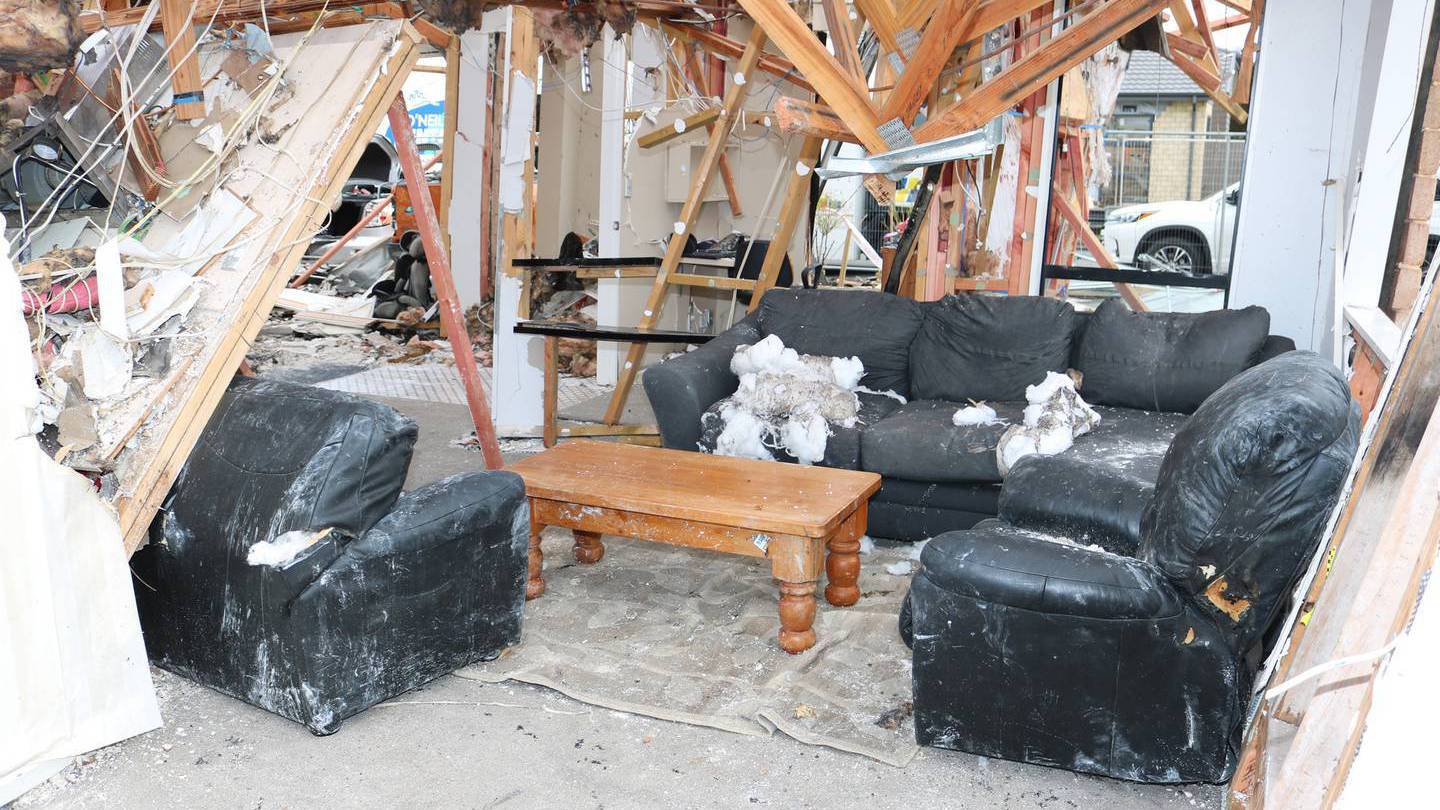
Gregory John Smith, sole director of Christchurch-based plumbing and gasfitting business Gas Unlimited Ltd, was halfway through repairing a gas fire when he didn't disconnect its gas pipe and then failed to tell homeowners not to use the gas.
The Herald revealed on Sunday for the first time just how gas leaked overnight through the Marble Court property in the northern suburb of Northwood and caused a massive explosion that sent destructive shockwaves through neighbouring properties.
Survivors, witnesses and fire bosses are all amazed nobody was killed.
Smith and his company were both later charged with failing to take action required by gas safety regulations.
He pleaded guilty at Christchurch District Court in September and was sentenced today.
Survivors of the blast, along with family members, filled the public gallery in the courtroom.
Judge Tony Zohrab made an order to permanently suppress the names of all blast victims.
The judge then heard victim impact statements about how the explosion affected them physically and mentally.
Nobody in the house that day has ever fully recovered, the homeowner said.
She lost "everything", including her home, car, contents, photos, memories and many irreplaceable personal items and has needed counselling.
"I don't know how I didn't lose my life," she said.
She still gets anxiety around gas fires and gas cooking, including BBQs.
Another victim was standing in the guest bedroom when the blast hit him, leaving him with burns to about 29 to 32 per cent of his body.
He was taken to Christchurch Hospital before being transferred to the Middlemore Burns Unit in Auckland where he stayed for five weeks.
People often tell him it's amazing he wasn't killed that day.
"By the grace of god we are all alive," he said. His life has been changed forever, the court heard, living with constant physical reminders while his partner has been left traumatised.
"I hold no bad feelings towards anyone else concerned with the explosion. It was avoidable but we all want to do this and move on as much as we can," he said.
The occupants suffered serious injuries, including burns, with one man being placed in an induced coma at hospital for close to a month.
One woman was so affected by the incident she does not actually recall it.
Several neighbours have also suffered degrees of psychological and emotional harm as a result of the blast.
WorkSafe prosecutor Dennis Dow said the accident was the result of a "negligent mistake" and something that was "foreseeable and preventable".
Smith's negligence, Dow said, fell well below the standards of a gasfitter that day.
The property damage was colossal – with the total financial effect yet to be confirmed but the court heard has exceeded $5m – with the house being completely destroyed. At least five of the neighbouring houses suffered damage significant enough to be deemed uninhabitable.
Dow described the injuries suffered as "incredibly serious", adding: "It is incredible that no-one lost their lives."
He also said the victims were vulnerable, given that they trusted a professional to come into their home and do work on something that is inherently dangerous. They had no control over the work, no understanding of what needed to be done to make it safe, and placed their entire trust in Smith.
And it was "incredibly easy to avoid", Dow said, saying all that was needed to be done was to seal the outlet gas pipe, or in other ways, including isolating it at the gas mains supply.
Terrible error of judgement
Smith, who has 35 years' experience in the industry, accepts he made a mistake.
Defence counsel Joseph Lill said he's genuinely remorseful and been left "shattered" by the event.
He went to the blast site immediately afterwards and cooperated with WorkSafe throughout. He met a number of the victims and cooperated with the restorative justice process.
Judge Zohrab said it was obvious that Smith was a "good citizen, a decent man who's made a terrible error of judgement which has had terrible consequences".
Smith is also facing a civil process, the court heard, while his company is still trading, employing eight people, but remains in a "delicate" position.
His licence was suspended after the explosion, Lill said, and Smith is still awaiting a final decision on whether he can return to gas-fitting work.
Judge Zohrab ordered Smith to pay $134,300 in emotional harm reparation, with the occupants of the Marble Court property each getting sums varying from $15,000 to $25,000. Payments of $5000 were ordered to go to three occupants of other properties.
The judge said he felt the amounts were a "proportionate response" given the payments needed, by law, to be made within five years and take into account Smith's ability to pay. He also didn't want the amounts to be so onerous that his company went to the wall.
Smith's company Gas Unlimited Ltd was also fined $82,500 and sentenced to 325 hours of community work.
The summary of facts says that Smith was phoned soon after the July 2019 blast by the fireplace manufacturers who he'd been talking to about getting a new part.
"I mustn't have … I can't have … I didn't cap the gas. It was the fire we were working on yesterday," a shocked Smith said on the phone, according to court documents obtained by the Herald.
He went straight to the epicentre of the blast scene and made himself known to police officers.
The people inside the property at the time of the explosion suffered varying injuries.In 2019, the property owner engaged Gas Unlimited to repair a gas fireplace heater, which was not working properly. When the homeowner tried to start it, the fan would run but the fireplace would not ignite.
A family member, who was an electrician, tested the fireplace and believed the problem might be with the solenoid – a valve component that controls the flow of gas from the inlet pipe through the fireplace. But they did not do any work because it appeared to be a gas rather than an electrical issue.
On June 17, 2019 Smith visited the property and examined the fireplace, which was displaying an error code on the controller.
Smith, who installed the fire in 2010, partially dismantled the fireplace but did not disconnect it from the pipework supply or cause any pipe to be open-ended, says the summary of facts obtained by the Herald.
Smith then called Escea – the fireplace manufacturers – who advised he send the computer board to their Dunedin office for testing.
After removing the computer board, Smith put the fireplace back together and left. He did not turn the gas off at all during his visit.On July 10, 2019, Smith returned with the computer board which had been tested but found it still showed the same error code.
The homeowner, who was there at the time, suggested to Smith that it might be the solenoid, and explained what their family member had said.
Smith phoned Escea again who talked him through some fault-finding tests, which resulted in him suspecting that two of the solenoid coils were faulty.
He returned on July 18, 2019 with replacement solenoid coils but found they were not the right parts.
Smith located the gas mains outside the house and turned the gas off at the isolating valve.
He then disconnected the solenoid and called Escea again to discuss the issue.An Escea technician suggested that Smith return both the new and old solenoid coils, the transformer, computer board and remote back to Escea so they could be tested as a set.
After the 54-minute phonecall, he left the property.But the summary of facts says that after removing the solenoid, Smith "did not take any steps to isolate the gas supply (other than turning it off at the mains)".
And he did not cap the appliance gas pipe or disconnect the fireplace from the gas pipe that supplied the appliance, or disconnect the installation and cap the supply pipework at the mains."
Mr Smith did not say anything to [the homeowner] about what he had done with the fireplace or what she could or could not do with the gas," the summary of facts says.
"In particular, he did not tell her that she should not turn the gas mains back on."Further, he did not place any type of labelling on the gas meter or take any steps to lock the gas valve to ensure that no one else could turn the gas back on."
That evening, the homeowner had some friends coming for dinner and to stay the night.When the homeowner tried to turn the gas hob on, they discovered none of the burners worked.
They realised Smith had not turned the gas back on at the mains after turning it off that afternoon.
With one of the visitors, they went outside and turned the gas mains back on.After turning the hob on, they immediately smelt gas but turned on the range hood and lit a candle on the dining table to remove the smell.
They stopped noticing the smell after less than a minute.
After dinner and then drinks in the lounge, some of them stayed up until 3.30am to watch a netball world cup match on TV.
It appears none of them noticed a smell of gas after the initial smell when the mains were first turned on. The mostly likely explanation, included in the summary of facts, is the concept of "odour fatigue" or "olfactory adaptation" where someone adapts to a smell and stops noticing it over time. However, gas flowed out of the open appliance gas pipe through the fireplace into the property "steadily throughout the evening and the following morning", the summary says.
A total of about 27cu m of gas flowed into the property over about 14 hours. Over the previous three-month period, the property had consumed about 1cu m of gas. "The concentration of gas inside the house may have built up at a slow enough rate for the occupants to become desensitised to it throughout the evening without noticing it," the summary says."
As gas had been flowing into the property throughout the evening, by the following morning there was a large volume of LPG resting inside the house.
"At around 10.10am, one of the visitors arose and turned on the electric jug and toaster in the kitchen.
The action of walking through the house "disturbed the low-lying LPG", causing it to mix with the air and "bringing it to within its explosive range". He returned to the bedroom.
The electric thermostat on a hot water cylinder in a linen cupboard near the centre of the house disengaged at 10.15am and "created a brief arc, generating a spark which ignited the gas/air mixture and caused it to explode".
"The explosion created a large blast pressure wave followed by a large fireball which emanated from the property," the summary of facts says.
"The property was immediately destroyed entirely. The shockwave caused damage to a number of neighbouring properties. Heavy debris from the explosion was thrown up to 100m from the property, and lighter debris was located throughout the neighbourhood."
On the day of the explosion, St John said six injured people were rushed to hospital with various injuries.
When Smith was interviewed by WorkSafe New Zealand, he acknowledged that he had failed to isolate the appliance from the gas supply.













